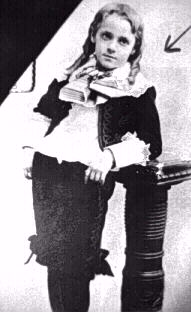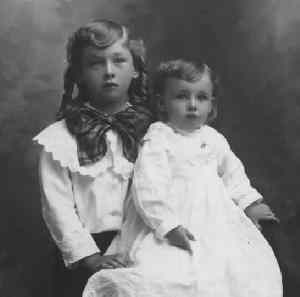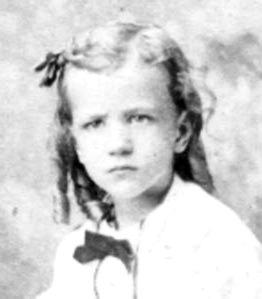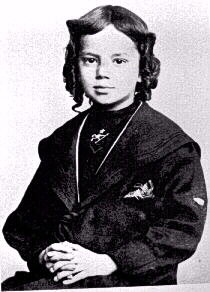
Figure 1.--Note the long ringlet curls on this older American boy which his mother has lovingly laid on his lace collar so they would be clearly visible. Note the boy's ceter part.


Figure 1.--Note the long ringlet curls on this older American boy which his mother has lovingly laid on his lace collar so they would be clearly visible. Note the boy's ceter part. |
Mothers who curled their soms hair developed different styles.
Creative mothers, themselves, however,
developed many differet styles. Some mothers curled their sons' hair into long, think curls.
Other mothers preferred a larger number of more slender curls. Other
variations included the
number of curls and many other factors like bangs and the treatment of the part and the rest
the boys' hair.
Plase note that I have little actual information on the different types of ringle curls. I have compiled this information based on an analysis of available images. If any HBC visitors have any historical information or insights, I'd be very interested in it.
Unkike boys' clothing and
fashion which were discussed in womens fashion magazines, styles for
curling boys' hair do not seem to have been discussed in such detail.
The styling of women's hair, however, was discussed in great
detail. Givemn the interest of women in hair styling, this must have
been an issue discussed in women's fashions magazines. Probably there were many articles advising women on hair styling. Probably women just used the prevalent styles for themselves and girls for their sons. The information in fashion magazines was presumably used my mothers in styling their sons' hair, even though there may have been little information, specifically about ringlet curls for boys.
The thickness of the curls varied from boy to boy. They looked to have been curled at about 1 centimeters in diameter. The thickness seem to have been related to the number of curls rolled. A few available images suggest thicker ringlets, perhaps as much as 1.5 centimeters.
Ringet curls most commonly were long, extending below the shoulders.
Mothers loved to carefully lay the curls
on the boys choulder so they would show on the photograph to maximum
affect. Hair this length would generally have to be on boys at least
5 or 6 years of age. Todler hair doesn't grow this long. Some boys
with long curls would have been 12 years of age or older. This probably is the upper limit of the number of curls rolled. Perhaps some boys might have had 14, but I doubt
it there were boys styled with larger numbers of ringlets.
Concerning the question of length. I think this was primarily a
question of a boys' age. A little boy could not have long ringlets.
By the time a boy was 5 or 6, a boy was old enough to have ringlets falling down to his shoulder and longer. I do not think a older boy ever had his curls trimmed so they didn't get to long, but I could be wrong about this.
Almost all available images of ringlet curls show the boys with at least shoulder-length ringlets. Presumably this means a boys hair was not curled until it was long enough to be at least shoulder length. Some of the older boys, however, have much longer ringlets. Some seem ti fall to as far as the mid chest.
Boys varied greatly in the number of ringlets that their mothers styled. Sometimes thee were only two major ringlets. Often their were six or more. Spmetimes the boy had two ringlets laid on their shoulders and the rest of the hair uncurled.
Unfortunately the vast proportion of the photographic images of boys in ringlet curls are photographed fron the front. It is thus not readily apparent as to how many ringlets the boy has. The mother is careful to lay at least two ringlets pn the boys lace collar or shoulder of his jacket or dress. But this leaves open the question of how many ringlets are cascading down the boys' back.
Some boys in ringlet curls also sported forehead bangs. Rather than have the center or side part come akk the way out to the forehead, various
Standard bangs or what we might call a Dutch boy cut staight accross
the forehead was one option. (Does anyone know if this cut got its name
because this was a popular hair style in Holland.) This was a fairly
simple approach. It was usually associated with a cebter part, but
the center part ended well before the forehead so the hair could be combed forward into bangs which were then cut straight across the forehead. Note that until the turn of the century it was
not common to style boys hair in bangs after his curls were cut. Nor
was it the most popular way of styling girls hair. Thus it was not used as widely for boys as other treatments.
Another common way of dealing with the center part, was to divide it
just before reaching the fore head. A tuft of hair would then be
combed forward in the area between the two branches from the center
part.

Figure 5.--This boy has long ringlets with a side part. Notice how his front bangs have been styled into a little curled sweep. |
Some boys were styled with a sweep or wave of hair at the front.
This could be styled with a side part and the wave would be swept of
from the part. This was to become a standard feature of boys' hair curs
in the mid-1950s, without of course the ringlets.
Some mothers appeared to have curled the boys bangs rather than having
them fall straight over his forehead. This seems to have been less
common than other styles, but
several available images show this style. There were several different
ways in which the bangs could be styled or curled. Some mothers were very
imaginable in this regard.
Many boy wth culed hair had distinct parts. This was the most common way of dealing with a boys hair when it was curled. The parts were usually center parts, but side parts also existed.
I'm not sure if the side or center pats had any significance as to
gender. One might have been used more for girls than for boys, but I
am not sure about this. Available family images show the whole family
in late 19th Century America with center parts, so it does not appear
to have been a major factor.
The part was a major stylistic feature of a boys hair with ringlet
curls. This probably is related to forming the curls. The easiest way is to sinply comb
the hair down from a central part. A side part would complicate this as more hair would be available on one side
and it would vary the lengths of strands to be curled. The poor boy
might look a bit lopsided.
Most of the boys with ringlet curls had very carefully styled hair. A few images, however, show boys with inglets, but rather untidy hair. This is a little surprising as one would think that a mother who went to the trouble of curling a boys hair would also be very insistent that his hair be perfectly done, especially for a formal family portrait.
Some mothers added hair bows to the long hair of their children. Relatively small bows were generally chosen for boys, unlike the sometimes huge hair boys often worn by girls. White hair bows appear to have been the moat comminThis seems to have been a popular style in France, but American, English, probanly Italian, and Scandinavian boys also wore hair bows. This was most common for uncurled hair as the bows were used for the utiliarian purpose of holding the boys' hair in place as well as for stylistic affect. This practice seens most common in the late 19th Cebtury, but continued into the 20th Century.

Figure 7.--This American boy in the 1870s wears ringlets with a hairbow. This style was more popular in France. |
Generally boys with ringlet curls did not also wear hairbows. I'm
not sure why this was. Americans who did not seem to object to ringlet curls and
dresses for boys, never embraced the addition of hairbows. There
were, however, some exceptions. The image of Dag Hammarskjold is a notable
exception. Even some American boys wore ringlet curls with hairbows.
The number of images, however, showing boys in ringlet
curls and hair bows is a very small number of the available images.
Boys wearing ringlet curls do not appear to have commonly worn caps. Such headgear seems to have more commonly been for older boys, at least boys dressed in more mature styles. Boys in curls, however, did wear hats. A hat has a full brim and not a partial brim like a cap. The most common style for boys in curls appears to have been
sailor hats with large brims, often with elastic chin straps. It should be noted that hats at the time were not optionla gear. Adults and children did not c ommonly leave home without donning an appropr iate hat.
One can imagine what boys must have thought about wearing ringlet curls. If all boys were coifured with ringlets it would have been one thing. While it was not rare, boys in long ringlets were a distinct

Figure 9.--Although unusual for the 1910s, noted American author Thomas Wolfe's mother insisted on long ringlet curls. Mercifully an Uncle took him at 9 years of age to the barber for a hair cut. |
Little boys of course did probably not concerned about it, although boys being boys it is likely that they objected to the nightly drugery of having their hair curled. Some younger boys probably liked the attention and glowing cpmpliments from mother's friends. Older boys did have some definite ideas. This was especially true once they reached the age in which making friends their own age
became increasingly important to them. Many men in their memoirs looking back remember their long curls with almost universal disgust.
While many men comment on wearing curls, there does not seem to
have been any specific complaint about the details of the style chosen
by their mother. It was just the long curls, looking just like those of
their sisters that they objected to. The actual stylistic details seem
to have been of little concern to the boy involved.
There is an extensive discussion in the HBC dress pages on
why mothers
outfitted boys in dresses during previous eras. Some insist that the
reason was primaryly utilitarian, associated with an easy garment for
caring for younger children. There is undoubtedly some validity in this, esprcially in the years before ribber pants, washing machines, and easy to wear boys' clothes. It is not, however, a completely satisfying reason. Why for example if this was the reason were older boys kept in dresses, some times boys of 11 and 12 years of age. Clearly more was involved. The fact that mothers curled boys hair is futher proof that more was involved. Dresses were considered children's clothes and not just girls clothes.
Curls on the other hand, in the 19th Century were definitely a girls or
woman's hair style. There was certainly nothing utilitarian about ringlet curls.
The mother's enchantment with curls could relate to a variety of attitudes, somes perhaps not fully articulated buy the mothers. Factors probably included the concept of childhood as an state of innosence and a view of beauty affected by fashions of the day--ringlet curls. Another factor must have been the woman's desire to hold on to their sons as long as possible, thus the dsire for fashions emphasing imaturity and
Related Links
Navigate the Boys' Historical Clothing hair style pages:
[Return to the Main hair page]
[Return to the Main long hair page]
[Return to the Main curl hair page]
[Bangs]
[Ringlet curls]
[Hair bows]
[Caps]
[Collar bows]
Navigate the Boys' Historical Clothing Web Site:
[Introduction]
[Chronology]
[Clothing styles]
[Biographies]
[Bibliographies]
[Activities]
[Countries]
[Contributions]
[Boys' Clothing Home]
